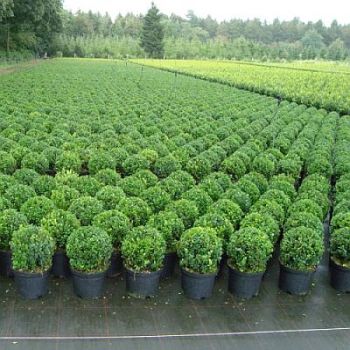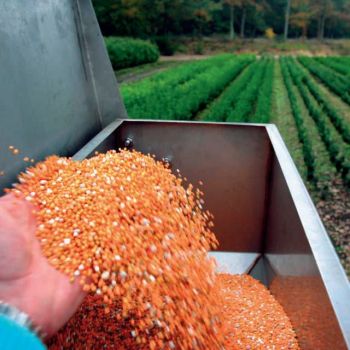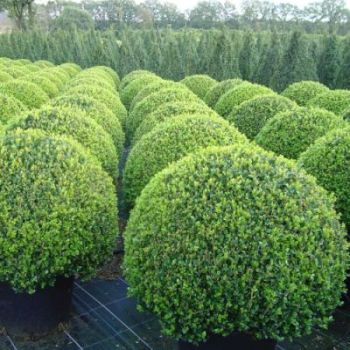FERTILIZATION
Buxus, especially the topiary forms, needs a lot of nutrition to remain green. If the dosage of fertiliser is too low, the plant will not grow sufficiently and the leaves will become a dull yellow colour and have yellow edges. A distinction should be made between fertilising in the full soil and in pots.
All our advice is based on experience gained in professional nurseries and based on average values. In order to offer precise advice, you need to have a soil analysis carried out. The nature of the soil is also very decisive: loamy or clay soils require less nutrition than sandy soils..
Compound fertilisers consist of different nutrients. Nitrogen (N), phosphate (P) and potassium (K) are the main elements. You can find the formula on the packaging. Magnesium (MgO) is also important for Buxus as it promotes a beautiful green colour. Calcium (Ca) is essential for Buxus, which is why extra lime is sometimes added. When using seaweed lime, you also add the necessary trace elements at the same time.
Fertilising full soil:
There are various systems for the private gardener:
Fertilisation with organic fertilisers:
These fertilisers are made from organic raw materials and are mild with little risk of burning. The average working period is 6 to 8 weeks. Therefore, several fertilisation rounds per year are necessary.
Average dose, depending on composition:
- April: 10 kg/are (100m²)
- June: 5 kg/are
- August: 5kg/are
These fertilisers do not need to be worked in. Extra magnesium in this fertiliser gives a nice green colour. Example: Orgabio 5-3-6+ 3% MgO
Fertilisation with coated fertiliser:
These granules are coated so that the nutrients are released slowly without the risk of burning. These fertilisers are eco-friendly because few nutrients spill out into the groundwater. The working period is 5 to 6 months depending on the formula chosen. One fertilisation per year will suffice in most cases. If necessary, a little extra fertilisation can be added in August.
Average dose, depending on composition:
- March/April: 7kg/are
- possibly August: 3 kg/are
Example: Agromaster 16-8-16+ 5%MgO.
TIP: Increase the dosage in gardens with many hedges or large trees. Application is possible in dry weather, but a shower or watering afterwards is ideal.
Fertilising IN POTS
Professional nurseries mainly use coated fertilisers such as Osmocote for growing in pots. Thanks to the special resin coating, the nutrients are released gradually so that the plants have sufficient nutrition at their disposal throughout the growing season. The growth will therefore be uniform. Depending on the formula chosen, the effect lasts approximately 6 months, so that one fertilisation per year is sufficient in most cases.
As this fertiliser also has virtually no washout, it is efficient and environmentally friendly.
- 30 grams per 10 litres of pot content (loose grains)
- or 4 tablets of 7.5 g/10 litres of pot content (tablet form)
Example: Osmocote




